|
Bishops
and Dioceses
Monasteries
Icons
and Holy Places
Publications
Education
Organizations
List
of Parishes
|
|
In
the period of the persecution of the faithful in Russia, many
refugees tried to preserve from desecration, destruction and
mockery all that was sacred to the Russian heart. Every icon,
every thread, every clump of earth connected with a holy site,
with a saint, was considered a sacred item. And in the diaspora,
the Lord showed His mercy and grace through the appearance
of new miracle-working icons, new saints and new holy objects.
All this is preserved as sacred in the monasteries and churches
of the Russian Diaspora. Almost evey church contains special
icons, relics and objects--they are countless. Here is a list
of the most important ones:
|
 |
 |
 |
 |

|
|
|
Kursk-Root
Icon of the Mother of God, Protectress of the Russian Diaspora
On 8 September, 1295, on the day of the Nativity of the Most-Holy
Mother of God, a small force of hunters from Rylsk came to
hunt at the Tuskora river, 27 versts from Kursk. One of the
hunters, an honorable and pious man, seeking prey in the woods,
found a small icon lying face down on the root of a tree.
He had barely lifted it to inspect it when the spot upon which
the icon lay burst out with a strong spring of pure water.
The icon turned out to be of the type referred to as the "Sign"
of the Mother of God. The hunter who found the icon knew that
this was no ordinary occurrence. He called his companions
and together they built a small wooden chapel, into which
they placed this icon. The residents of Rylsk, hearing of
the newly-appeared icon of the Mother of God, began to visit
it for veneration, and many miracles began to appear from
it.
In 1385 the Kursk region was again swept by the Tatars. They
tried to burn down the chapel and its Icon, but the wooden
structure would not burn. The priest who lived by the chapel,
Fr. Bogolep, explained to them that the reason for this miracle
was the Icon itself. The incensed Tatars hacked the Icon in
half and tossed the pieces in different directions, then burned
the chapel.
They took the priest prisoner and was forced to tend to Tatar
flocks. Some time later he was ransomed by emissaries of the
Muscovite Grand Duke who were on their way to the Golden Horde,
and he returned to the place where the chapel had stood. After
a long search, while praying and fasting, he found both halves
of the holy Icon, placed them side by side, and they grew
together seamlessly, exhibiting only something "like
dew".
In 1676 the holy Icon traveled to the Don River for blessing
the Don Cossack troops. In 1684 Tsars Ivan and Petr Alekseevich
sent a copy of this Icon with the order that it accompany
Orthodox troops into battle. In 1687 the holy Icon was sent
to the "Great Army." In 1689 copies of the holy
Icon were given to the armies in the Crimean campaign. In
1812 a copy of the holy Icon was sent to Prince Kutuzov and
the battling troops. Before his icon St. Seraphim of Sarov
prayed and was healed.
On the night of 7-8 March, 1898, conspirator revolutionaries-atheists
tried to blow up the Miracle-working Icon with a hellish bomb,
but the Lord Jesus Christ glorified His Most-Pure Mother yet
more, for despite the terrifying destruction in the cathedral
surrounding the Icon, it remained untouched.
On 12 April 1918, the holy Icon was stolen from the cathedral
of the Monastery of the Sign of the Mother of God and stripped
of its ornamentation, but on 2 May it was found and returned
to its place.
Finally, in 1919, while accompanying Bishop Feofan of Kursk
and Oboyan’ and some monks of the Monastery of the Sign,
the holy Icon crossed the border to the neighborly Serbia.
In 1920 it again, at the behest of General Wrangel, visited
Russia at the Crimea and remained there until the final evacuation
of the Russian Army in the first days of November, 1920. The
holy Icon returned to Serbia, where it remained until 1944,
when, together with the Synod of Bishops, it went abroad,
to Munich (Bavaria) with Metropolitan Anastassy. In 1951 Metropolitan
Anastassy moved from Munich to America. Since 1957 the Icon
had resided in the main cathedral dedicated to it in the Synod
of Bishops in New York. The holy Icon regularly travels to
all the dioceses of the Russian diaspora
|
 |
| |
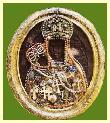
|
|
|
The
Lesna Icon of the Mother of God
The Lesna
Icon of the Mother of God
The Lesna Icon was found on 14 September 1683 by a shepherd,
Alexander Stelmashuk, of the town of Lesna, Bel’sky uezd,
Grodnenskaya guberniya, in a thick forest on a pear tree surrounded
by a bright light.
The holy icon did not stay with the shepherd. It was confiscated
by a Catholic Polish landowner. Misfortunes which then befell
him moved him to give the icon to an Orthodox church in the
town of Bukovich, near Lesna. Then again it was taken away
by Catholics and placed in a Catholic church, which, in 1863,
was handed over to the Orthodox faithful. At the same time
the holy icon was returned.
The icon is carved into a dark red oval stone. Some 500 miracles
from it have been counted. It's feast day is on Pentecost,
and on 8 September. The Icon is kept in France, at Lesna Convent
in Provemont. Only once did it leave the Convent--on the 1000-year
anniversary of the Baptism of Russia in Paris.
|
 |
| |

|
|
|
The
Incorrupt Relics of Hierarch John
The relics of St. John—the Miracle-worker of Shanghai
and San Francisco and the twentieth century’s great ascetic,
archpastor and man of prayer--were found to be incorrupt in
1993, on the threshold of his glorification. The relics were
transferred from the burial-vault beneath the church into
the very Cathedral of the Most Holy Theotokos, the Joy of
All Who Sorrow, in San Francisco, during the glorification
of St. John in 1994. His relics are the only intact relics
open for veneration in North America. Numerous pilgrims come
from all the countries of the world to pray at St. John’s
relics. General prayers are performed weekly at the reliquary,
and oil is sent all over the world from an ever-burning lamp.
The Liturgy is performed daily in the cathedral church, and
there is access during all services to the holy relics.
|
 |
| |
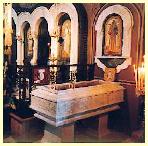
|
|
|
The
Relics of the Holy New Venerable-martyr Elizabeth Feodorovna
The holy New Venerable-martyr Grand Duchess Elizabeth Feodorovna
and her faithful cell-attendant, Nun Barbara, accepted a martyric
end at the hands of the atheists in Alapaevsk in 1918. The
remains of the holy Martyrs were conveyed to the Russian Ecclesiastical
Mission in Peking, and from there they were transferred on
an English ship to Jerusalem and interred at the Church of
St. Mary Magdalene in Gethsemane. On the threshold of the
glorification of the assembly of the holy New-martyrs and
Confessors of Russia by the Russian Church in 1981, the holy
remains of the holy New-martyrs were opened and transferred
into the very Church of St. Mary Magdalene, where, in accordance
with St. Elizabeth’s desire, they rest to this day. Russian
pilgrims to the Holy Land visit the Church of St. Mary Magdalene
without fail in order to kiss the relics of the holy New-martyrs
and to pray to them.
|
 |
| |
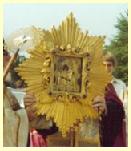
|
|
|
A
Venerated Copy of the Pochaev Icon of the Mother of God
In 1934, an exact copy of the Pochaev Icon of the Mother of
God was sent from the holy mountain of Pochaev to the Ascension
Cathedral in the Bronx (New York City) as a blessing to American
Russia. This holy object was solemnly greeted and placed above
the royal gates of the Ascension Cathedral. Subsequently,
this icon would be brought each year to Holy Trinity Monastery
in Jordanville for the public festivity of the feast of Venerable
Job of Pochaev. Before it, an akathist would be performed.
When the cathedral in the Bronx was closed, the icon was removed
to Jordanville and placed in a case in the lower church of
St. Job. At the present time, the icon is transferred on the
day of the feast of the Dormition to the Dormition cemetery
church and remains there until the celebration of the commemoration
of Venerable Job, when, as before, it is met by a procession,
and an akathist is performed before it.
|
 |
| |

|
|
|
The
Portrait-Icon of Venerable Seraphim of Sarov
This original portrait of the saint, painted during the holy
man’s lifetime, is in the Novo-Diveevo Convent near New
York. The Venerable one is depicted in full stature in his
declining years. He is leaning on a staff in his right hand,
and in his left hand he holds a prayer-rope. As those who
have seen this portrait state – “the wondrous face
of the Venerable one has remained completely undamaged by
time. From the Venerable one’s face, pale and emaciated
by ascetic struggles, the holy Elder’s blue, amazingly
communicative eyes gaze. It is impossible to tear oneself
away from this gaze: He looks directly at your soul, and it
seems that the saint’s glance--at times kindly, at times
sternly--penetrates into all the corners of your soul.”
During the days of the saint’s glorification in 1905,
the whole Royal Family prayed fervently before this image.
During the destruction of the Convent by the Bolsheviks, the
image was taken to Kiev, where it was situated in the Neberezhno-Nikol’sky
Church, and in 1945 it was transferred to the Protection Church,
newly opened under the Germans, in Podol. During the retreat
of the Germans from Kiev, the image was taken out by one of
the translators (a Russian Orthodox Christian) to Lodz’,
and then handed over to Protopresbyter Adrian Rymarenko, who
was then the rector of the Russian Cathedral in Berlin. During
one of the brutal nighttime air-raids against Berlin, those
returning from shelter saw that an incendiary bomb, having
pierced the cupola of the Cathedral, had fallen into its left
side-chapel. The Shroud situated there and the image of the
Venerable one that lay upon it were enveloped in fire; next
to it, the stand for the Cross and the nearby image of Saints
Gurias, Samonas, Abibas were burning. The fire was quickly
extinguished, and remarkably, the flame did not at all touch
either the Shroud or the image of St. Seraphim, even though
everything round about was scorched. The night passed. The
morning divine service began, but the smell of burning did
not disappear; on the contrary, it became all the more intense.
They rushed again to seek the cause, and in the Cathedral’s
attic they discovered a second, smouldering incendiary bomb.
They had hardly touched it, when a huge shaft of flame leapt
up from it. Thus, the fire smouldered for twelve hours but
did not flare up. From that moment, the Cathedral did not
suffer from fire any more, although everything around it was
burnt and destroyed.
In accordance with God’s inscrutable ways, the flow of
Russian people surged to America, and with them also arrived
the Diveevo holy object – the image of the Venerable
one – as well a particle of his holy relics and a piece
of his mantia.
|
 |
| |
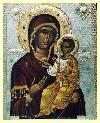
|
|
|
The
Montreal Myrrh-streaming Iveron Icon of the Mother of God.
The Montreal Iveron Icon was painted on Athos in 1981 by a
Greek monk from the original Icon of the Mother of God the
Portaitisa. In 1982, Jos_ Mu_oz Cortez, a Spaniard by origin
who had long ago accepted Orthodoxy, brought this icon from
Athos to Montreal, Canada. Here is what happened, said Jose
Munoz: “On the 24th of November, at three o’clock
in the morning, I was wakened by a powerful fragrance. At
first I thought that it came from relics or a spilled bottle
of perfume; but on going up to the icon, I was awestruck:
it was entirely covered with fragrant myrrh! I froze on the
spot at such a miracle! Soon the myrrh-streaming icon was
taken to church. From that time, the Icon of the Mother God
has continuously streamed myrrh, with the exception of Passion
Week. It is remarkable that the myrrh has flowed out mainly
from the hands of the Mother of God and Christ, and also from
the star on the right shoulder of the Immaculate one. At the
same time, the back side of the icon is always dry.”
The wonderworking image has been in America, Australia, New
Zealand, Bulgaria and Western Europe. No matter where this
icon has been, it has spread love and concord everywhere,
as, for example, in one community where the quarreling parishioners
found once again the way to prayer and church unity. Its presence
increased prayerful fervor to such an extent that Liturgies
performed in its presence could be compared to paschal Liturgies,
which are so intense in the Orthodox Church.
Many cases of people’s return to attending church, to
going to Confession, to receiving Communion are known. Thus,
one poor woman, having learned of the death of her son, prepared
to take her own life; but touched to the depths of her soul
at the sight of the wonderworking icon, she repented of her
horrible intention and immediately went to Confession.
The icon streamed myrrh for fifteen years. On the night of
30-31 October 1997, the custodian of the icon – Jos_
Mu_oz Cortez – was brutally killed in Athens, and the
wonderworking Iveron Icon vanished without a trace…
|
 |
| |
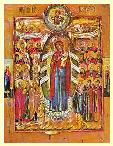
|
|
|
The
Harbin Icon of the Mother of God "Joy of All Who Sorrow"
In the 1920's in the Far East, in the city of Harbin a young
Bishop Nestor, through his labors and efforst established
the "House of Mercy," a charitable institution/hostel,
both for the elderly and sick and for orphaned children. At
this House of Mercy, Bishop Nestor set up and consecrated
a church in honor of the Icon of the Mother of God "Joy
of All Who Sorrow." Learning of this, one of the Bishop's
close assistants, a deeply-religious Russian woman, Ekaterina
Ivanovna Kurmey, donated her own icon of this type. The ancient
icon had already darkened so much from time that it was almost
impossible to discern the faces of the saints, let alone reading
the inscriptions.
One day, the rector of the church, now deceased, Fr. Julian
Sumnevich (particularly revered by the Orthodox residents
of Harbin for his spirituality and irreproachable life) noticed
that the old icon began to lighten and renew itself...Not
believing his eyes, he decided to wait some time; but the
renewal was progressing quickly, and in a few hours the icon
was so bright that the miracle was undoubtable and apparent
to everyone who saw it and knew its previous condition.
Within a day, the holy Icon was absolutely bright, the faces
of the saints and the inscriptions were distinct and so clear
that one could believe that the Icon had only just been painted.
This stupendous miracle of God's grace roused the entire city.
Old residents of Harbin remember this event well. Believers
from all over began coming to the new holy Icon to venerate
it and pray--and the renewed Icon became one of the most important
holy objects not only of the church, but of all of Orthodox
Harbin.
When the last rector of the church of the House of Mercy,
Archimandrite Philaret (later the third First-Hierarch of
the Russian Orthodox Church Outside of Russia), also left
Harbin for Australia after great difficulty, and then on to
the USA, the renewed Icon remained in this church, along with
other holy objects. The church was closed after its rector
had left, and its holy objects and items became the property
of the Chinese government. After many strenuous and difficult
efforts, the acting warden of the church of the previous several
years, Z.L. Tauz-Zvereva managed to gain permission to export
the holy Icon. Only in the fall of 1965, during Vladyka Metropolitan
Philaret's trip to Europe, was the renewed Icon, after a lengthy
stay in Hong Kong, sent to the USA to the Synodal Cathedral
of the Russian Orthodox Church Outside of Russia, where it
remains in the lower church of St. Sergius of Radonezh. The
present clergy of the Synodal Cathedral bear witness to the
fact that occasionally, myrrh appears on the surface of the
Icon.
|
 |
 |

|
 |
|
The
Holy Blood of the Royal Martyrs
In the Cathedral of the Most-Holy Mother of God "Joy
of All Who Sorrow" in San Francisco is a special icon
of the Holy Royal Martyrs. The icon was painted by a student
of Archimandrite Kyprian, Archbishop Alypy. Two relics are
housed in the icon: an icon of the Mother of God "Sky
of Grace" which belonged to the Royal Family in Ekaterinburg.
The icon was donated to the Cathedral by Grand Duke Nikita
Alexandrovich Romanov.
The second relic is a medallion with a chip from the wall
of the Ipatiev House. This wall was splattered with the martyric
Royal blood. A general of the Rifled Life-Guards of the Tsarskoye
Selo division, Alexander Alexeevich Tyunegov, being in Kolchak's
Army in 1918, escorted the investigator Sokolov to the Ipatiev
House and witnessed the condition of the basement where the
brutal act was committed. A.A. Tyugenov later found himself
in Australia and, after his death, the medallion with the
relic was passed on to Archbishop Anthony of Western America
and San Francisco of blessed memory.
|
 |
| |
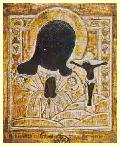
|
|
|
The
Akhtyrka Icon of the Mother of God
"Three years since the day of the transposition of the
icon to the house, on the day of the Protection of the Most-Holy
Mother of God, a priest entered the room where the icon was
and was struck by the unusual light emanating from it; this
phenomenon began to occur over and over, but the priest piously
prayed and spoke to no one of it. As soon as he fell into
a light sleep, the priest saw the Mother of God and heard
her instructions: to clear the icon of dust and wash it with
clean water. The priest, waking from his slumber, immediately
went to fulfill the will of the Mother of God, cleaning it
of dust, washing it with pure water and gathered the water
into a basin to pour it into the river the following day.
Afterwards, he fell asleep again, and saw in his dream that
he is approaching the river with the basin of water with which
he cleaned the icon, but on the way, he heard the voice of
the Mother of God: "Return home and keep this water;
it will heal all those suffering from fever." The priest
had a daughter who had for a long time suffered from fever;
awakening, he gave her this water to drink, and the daughter
was instantly cured. After that, all who suffered from fever
would come to this icon in prayer and would be healed."
The priest put the Icon into Holy Protection Church. As Bishop
Philaret writes: "In the church, wondrous healings of
various sick people flowed from the holy icon, and its glory
spread to faraway places."
As is always the case in such instances, the Church was obligated
to conduct an "investigation" of the miracles of
the holy icon, since groundless faith or deceit in this matter
could bring the truth more damage than even stubborn disbelief.
The investigation lasted for eight years, and since the "historical
veracity of the miraculous occurrences proved to be indubitable,
both by their circumstances and by the variety of miraculous
events," the Holy Synod in 1751 recognized the Akhtyrka
Icon of the Mother of God as miracle-working. In 1753, on
the site of the appearance of the Miracle-working Icon, at
the order of Empress Elizabeth, a new Church of the Protection
was built of stone.
During the revolution, the icon disappeared, but later turned
up mysteriously in Harbin and was acquired by S.A. Stepanov.
According to protopriest N. Trufanov of Harbin, who had often
venerated the Icon in Akhtyrka, the one acquired by Stepanov
was that same Miracle-working Icon of Akhtyrka. In the 1950's,
S. Stepanov took the Icon to Brazil, and then to San Francisco,
where he handed it over to the Committee of Russian Orthodox
Youth as a blessing. At the present time the Icon is under
the auspices of Archbisho Hilarion of Sydney and the Australian
and New Zealand Diocese.
|
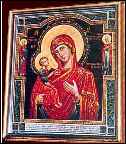
The Copenhagen Myrrh-Streaming Icon
of the Mother of God.
On Friday of the first week of Great Lent, 1995, in
the church of St. Alexander Nevsky Church in Copenhagen,
an icon of the Most-Holy Mother of God of Jerusalem
began to emit myrrh. This Icon, an exact replica of
the miracle-working icon kept over the Royal doors of
the Protection of the Most-Holy Mother of God in St.
Panteleimon Monastery on Mt. Athos, was painted at that
monastery in 1911-13 and sent as a gift to Empress Maria
Feodorovna on 22 April 1928 by monk Denasios. The Athos
Icon, in turn, is a copy of the miracle-working Icon
from the Krivozerkiy Hermitage (Kostroma guberniya),
painted in 1825 by Fr. Nikon, a hieromonk of the Nil
of Sora Hermitage.
On the eve of the holidays of the Mother of God, at
vigil and on Sundays after vespers, Athonite monks lower
this icon and an akathist is read before it. A lengthy
inscription on the verso of the icon sent by Fr. Denasios
to Denmark states that the icon was being sent by the
long-suffering Empress Mother in consolation, with a
prayer that the Most-Holy Mother of God does not abandon
the much-suffereing Russian land and Russian people
in the homeland and abroad.
At the present time, the Icon is framed under glass.
The streaming of myrrh continues, but only during divine
services. A few tears appear which stream down and quickly
evaporate without reaching the bottom of the frame.
For the second time in a short period the children of
the Russian Orthodox Church Outside of Russia have become
witnesses to a miracle. For the second time an icon
of the Mother of God (as was the Iveron Myrrh-streaming
Icon, which also hailed from Mt. Athos, of the Most-Holy
Mother of God) began to emit myrrh. What do these events
signify? Is it consolation for all of us, or is it a
warning? Inscrutable are the ways of the Lord and unfathomable
for the mind of man are the mysteries of His Providence.
Humbling one’s self-absorbed mind before the miracle,
let us be horrified at our lukewarm attitude, for the
Most-Holy Virgin weeps while looking upon mankind, at
her own kind, who are obstinate and bitter. The everlasting
and life-creating Divine power made dry wood and mineral
paint stream with aromatic empathy. Let us pray our
Most-Holy Intercessor to give life to our own wooden
hearts. Most-Holy Mother of God, save us!
|
|
 |
|